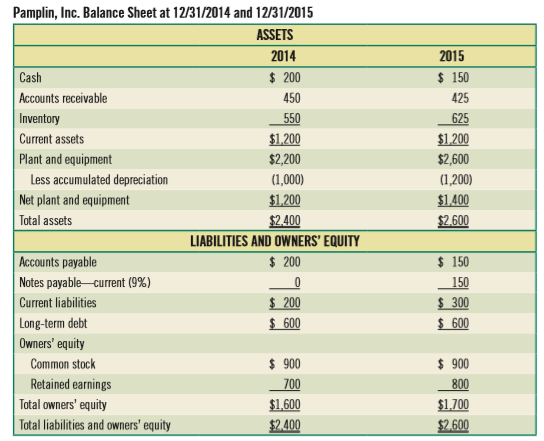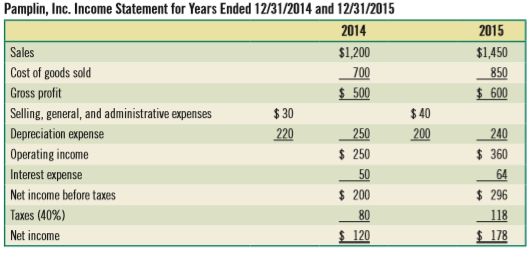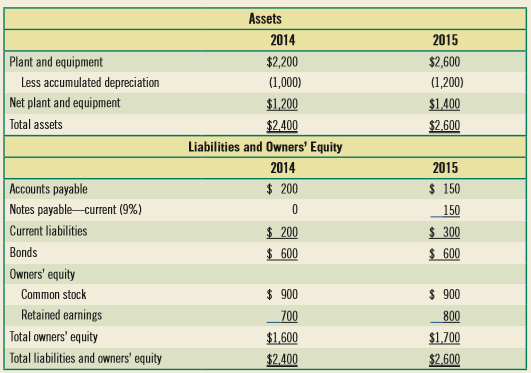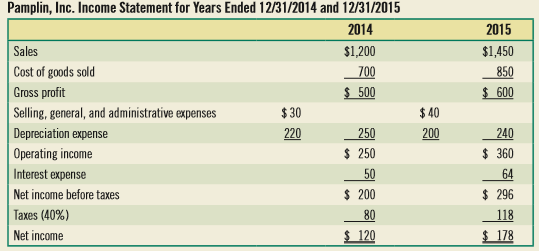Question: In Problem 3-14, you were asked
In Problem 3-14, you were asked to prepare a statement of cash flows for Pamplin Inc. Pamplin’s financial statements are provided again on the next page. Using this information, compute the firm’s free cash flows and the financing cash flows, and interpret your results.


Data from Study Problems 3-14:
a. How much is the firm’s net working capital, and what is the debt ratio for 2014 and 2015?
b. Complete a common-sized income statement, a common-sized balance sheet, and a statement of cash flows for 2015. Interpret your results.



Transcribed Image Text:
Pamplin, Inc. Balance Sheet at 12/31/2014 and 12/31/2015 ASSETS 2014 2015 Cash $ 200 $ 150 Accounts receivable Inventory 450 425 550 625 Current assets $1,200 Plant and equipment $1,200 $2,600 $2,200 Less accumulated depreciation (1,000) (1,200) Net plant and equipment $1,200 $1.400 Total assets $2.400 $2.600 LIABILITIES AND OWNERS' EQUITY $ 200 Accounts payable Notes payable current (9%) $ 150 150 $ 200 $ 600 $ 300 $ 600 Current liabilities Long-term debt Owners' equity Common stock $ 900 $ 900 Retained earnings 700 800 Total owners' equity $1,600 $1.700 Total liabilities and owners' equity $2.400 $2,600 Pamplin, Inc. Income Statement for Years Ended 12/31/2014 and 12/31/2015 2014 2015 Sales $1,200 $1,450 Cost of goods sold Gross profit 850 700 $ 500 $ 600 Selling, general, and administrative expenses $ 30 $ 40 depreciation expense 220 250 200 240 Operating income $ 250 $ 360 Interest expense 50 64 Net income before taxes $ 200 $ 296 Taxes (40%) 80 118 Net income $ 120 $ 178 Pamplin, Inc. Balance Sheet at 12/31/2014 and 12/31/2015 Assets 2014 2015 Cash $ 200 $ 150 Accounts receivable 450 425 Inventory 550 625 Current assets $1,200 $1,200 Assets 2014 2015 Plant and equipment $2,200 (1,000) $1,200 $2.400 $2,600 Less Accumulated depreciation (1,200) Net plant and equipment $1,400 Total assets $2.600 Liabilities and Owners' EQUITY 2014 2015 Accounts payable $ 200 $ 150 Notes payable current (9%) 150 $ 200 $ 600 $ 300 $ 600 Current liabilities Bonds Owners' equity Common stock $ 900 $ 900 Retained earnings 700 800 Total owners' equity $1,600 $1.700 Total liabilities and owners' equity $2,400 $2.600 Pamplin, Inc. Income Statement for Years Ended 12/31/2014 and 12/31/2015 2014 2015 Sales $1,200 $1,450 Cost of goods sold 700 850 Gross profit $ 500 $ 600 Selling, general, and administrative expenses $ 30 $ 40 depreciation expense 220 250 200 240 Operating income $ 250 $ 360 Interest expense 50 64 Net income before taxes $ 200 $ 296 Taxes (40%) 80 118 Net income $ 120 $ 178
> What is a beta? How is it used to calculate r, the investor’s required rate of return?
> What is the security market line? What does it represent?
> How would an increase in the interest rate (r) or a decrease in the holding period (n) affect the future value (FVn) of a sum of money? Explain why.
> What additional factors are encountered in international as compared with domestic financial management? Discuss each briefly.
> How do we measure the beta of a portfolio?
> Identify three distinct ways that savings are ultimately transferred to business firms in need of cash.
> Discuss briefly the two perspectives that can be taken when performing a ratio analysis.
> In the New York exchange market, the forward rate for the Indian currency, the rupee, is not quoted. If you were exposed to exchange rate risk in rupees, how could you hedge your position?
> Over the past eight decades, we have had the opportunity to observe the rates of return and the variability of these returns for different types of securities. Summarize these observations.
> A cash budget is usually thought of as a means of planning for future financing needs. Why would a cash budget also be important for a firm that has excess cash on hand?
> What is the objective of capital structure management?
> Define the term operating leverage. What type of effect occurs when the firm uses operating leverage?
> Define the term financial leverage. Does the firm use financial leverage if preferred stock is present in its capital structure?
> Define the EBIT-EPS indifference point.
> What does the term independence hypothesis mean as it applies to capital structure theory?
> In the preceding chapter we examined the payback period capital-budgeting criterion. Often this capital-budgeting criterion is used as a risk-screening device. Explain the rationale behind its use.
> How should managers compare two mutually exclusive projects of unequal size? Should the approach change if capital rationing is a factor?
> Explain the relationship between the required rate of return and the value of a security.
> Define the term structure of interest rates.
> If we were to graph the returns of a stock against the returns of the S&P 500 Index, and the points did not follow a very ordered pattern, what could we say about that stock? If the stock’s returns tracked the S&P 500 returns very closely, then what coul
> Explain the impact of inflation on rates of return.
> What is a general definition of the intrinsic value of an asset?
> What are the assumptions made by the EOQ model?
> Why would a firm repurchase its own stock?
> What are the advantages of a stock split or dividend over a cash dividend?
> How does a firm’s liquidity position affect the payment of dividends?
> State how investors’ expected rate of return is computed.
> Define investors’ expected rate of return.
> What is net working capital?
> What are the two major objectives of the firm’s cash management system?
> What is (a) unsystematic risk (company-unique or diversifiable risk) and (b) systematic risk (market or non diversifiable risk)?
> This Mini Case is available in My Finance Lab. After graduating from college in December 2014, Elizabeth Arce started her career at the W&T Corporation, a small- to medium-sized warehouse distributor in Nashville, Tennessee. The company was founded b
> What is the residual dividend theory?
> Explain the trade-off between retaining earnings internally and paying cash dividends.
> What is meant by the term dividend payout ratio?
> Knutson Products Inc. is involved in the production of airplane parts and has the following inventory, carrying, and storage costs: 1. Orders must be placed in round lots of 100 units. 2. Annual unit usage is 250,000. (Assume a 50-week year in your calcu
> A downtown bookstore is trying to determine the optimal order quantity for a popular novel just printed in paperback. The store feels that the book will sell at four times its hardback figures. It would, therefore, sell approximately 3,000 copies in the
> The following ratios were supplied by six loan applicants. Given this information and the credit-scoring model developed by Altman (equation [17-4]), which loans have a high probability of defaulting next year? EBIT + TOTAL ASSETS MARKET VALUE OF
> Determine the effective annualized cost of forgoing the trade credit discount on the following terms: a. 1/10, net 20 b. 2/10, net 30 c. 3/10, net 30 d. 3/10, net 60 e. 3/10, net 90 f. 5/10, net 60
> Assuming a 360-day year, calculate what the average investment in inventory would be for a firm, given the following information in each case. a. The firm has sales of $600,000, a gross profit margin of 10 percent, and an inventory turnover ratio of 6. b
> The Cowboy Bottling Company will generate $12 million in credit sales next year. Collection of these credit sales will occur evenly over this period. The firm’s employees work 270 days a year. Currently, the firm’s processing system ties up 4 days’ worth
> Two years ago your corporate treasurer purchased for the firm a 20-year bond at its par value of $1,000. The coupon rate on this security is 8 percent. Interest payments are made to bondholders once a year. Currently, bonds of this particular risk class
> a. What is meant by the investor’s required rate of return? b. How do we measure the riskiness of an asset? c. How should the proposed measurement of risk be interpreted?
> Bradford Construction Supply Company is suffering from a prolonged decline in new construction in its sales area. In an attempt to improve its cash position, the firm is considering changes in its accounts-payable policy. After careful study, it has dete
> The Alex Daniel Shoe Manufacturing Company currently pays its employees on a weekly basis. The weekly wage bill is $500,000. This means that on average the firm has accrued wages payable of ($500,000 + $0)/2 = $250,000. Alex Daniel Jr. works as the firm’
> Peggy Pierce Designs Inc. is a vertically integrated, national manufacturer and retailer of women’s clothing. Currently, the firm has no coordinated cash management system. A proposal, however, from the First Pennsylvania Bank aimed at speeding up cash c
> Penn Steelworks is a distributor of cold-rolled steel products to the automobile industry. All of its sales are on a credit basis, net 30 days. Sales are evenly distributed over its 10 sales regions throughout the United States. Delinquent accounts are n
> As CFO of Portobello Scuba Diving Inc. you are asked to look into the possibility of adopting a lockbox system to expedite cash receipts from clients. Portobello receives check remittances totaling $24 million in a year. The firm records and processes 10
> The Mason Falls Mfg. Company just acquired a depreciable asset this year, costing $500,000. Furthermore, the asset falls into the 7-year property class using the MACRS. a. Using the MACRS, compute the annual depreciation. b. What assumption is being made
> In Study Problem 3-12, you were asked to prepare a statement of cash flows for Abrahams Manufacturing Company. Use the information given in the problem to compute the firm’s free cash flows and the financing cash flows, and interpret yo
> Interpret the following information regarding Maness Corporation’s free cash flows and financing cash flows. Maness Corporation Free Cash Flows and Financing Cash Flows Free cash flows Operating income (EBIT) $1,875 Depreciation
> Given the following information, compute the firm’s free cash flows and the financing cash flows. Dividends……………………………………………………. $ 25 Change in common stock………………………………$ 27 Change in inventories……………………………………$ 32 Change in accounts receivable……………………….
> What is an annuity? Give some examples of annuities. Distinguish between an annuity and a perpetuity.
> Gio’s Restaurants is considering a project with the following expected free cash flows: YEAR……………………...PROJECT CASH FLOW 0 ………………………………………………...$150 million 1……………………………………………………90 million 2……………………………………………………70 million 3 ………………………………………………….90 millio
> Calculate the PI given the following free cash flows if the appropriate required rate of return is 10 percent. YEAR……………………………. CASH FLOWS 0 ………………………………………………2$55,000 1……………………………………………………10,000 2……………………………………………………10,000 3……………………………………………………10,000
> Calculate the MIRR given the following free cash flows if the appropriate required rate of return is 10 percent (use this as the reinvestment rate). YEAR………………………….CASH FLOWS 0 ………………………………………….2$50,000 1………………………………………………. 25,000 2……………………………………………….
> Calculate the NPV given the following free cash flows if the appropriate required rate of return is 10 percent. YEAR………………CASH FLOWS 0 ……………………………...2$70,000 1…………………………………. 30,000 2…………………………………. 30,000 3…………………………………30,000 4 ……………………………. 230,000 5………
> Calculate the NPV given the following free cash flows if the appropriate required rate of return is 10 percent. YEAR……………………………CASH FLOWS 0 ……………………………………………2$60,000 1…………………………………………………20,000 2………………………………………………...20,000 3…………………………………………………. 10,000 4
> The Tiffin Barker Corporation is considering introducing a new currency verifier that has the ability to identify counterfeit dollar bills. The required rate of return on this project is 12 percent. What is the IRR on this project if it is expected to pr
> Mooby’s is considering building a new theme park. After future cash flows were estimated, but before the project could be evaluated, the economy picked up and with that surge in the economy interest rates rose. That rise in interest rates was reflected i
> Big Steve’s, a maker of swizzle sticks, is considering the purchase of a new plastic stamping machine. This investment requires an initial outlay of $100,000 and will generate free cash inflows of $18,000 per year for 10 years. a. If the required rate of
> Determine the IRR on the following projects: a. An initial outlay of $10,000 resulting in a single free cash flow of $17,182 after 8 years b. An initial outlay of $10,000 resulting in a single free cash flow of $48,077 after 10 years c. An initial outlay
> The common stock for the Bestsold Corporation sells for $58. If a new issue is sold, the flotation costs are estimated to be 8 percent. The company pays 50 percent of its earnings in dividends, and a $4 dividend was recently paid. Earnings per share 5 ye
> Suppose you were considering depositing your savings in one of three banks, all of which pay 5 percent interest; bank A compounds annually, bank B compounds semiannually, and bank C compounds daily. Which bank would you choose? Why?
> Saddle River Operating Company (SROC) is a Dallas-based independent oil and gas firm. In the past, the firm’s managers have used a single firm-wide cost of capital of 11 percent to evaluate new investments. However, the firm has long recognized that its
> In May of this year Newcastle Mfg. Company’s capital investment review committee received two major investment proposals. One of the proposals was issued by the firm’s domestic manufacturing division, and the other came from the firm’s distribution compa
> Compute the cost of the following: a. A bond that has $1,000 par value (face value) and a contract or coupon interest rate of 9 percent. A new issue would have a flotation cost of 5 percent of the $1,100 market value. The bonds mature in 10 years. The fi
> LPT Inc. is an integrated oil company headquartered in Dallas, Texas. The company has three operating divisions: oil exploration and production (commonly referred to as E&P), pipelines, and refining. Historically, LPT did not spend a great deal of time t
> Newcomb Vending Company manages soft drink dispensing machines in western Tennessee for several of the major bottling companies in the area. When a machine malfunctions, the company sends out a repair technician; if he cannot repair it on the spot, he pu
> ABBC, Inc. operates a very successful chain of yogurt and coffee shops spread across the southwestern part of the United States and needs to raise funds for its planned expansion into the Northwest. The firm’s balance sheet at the close
> The capital structure for the Carion Corporation is provided here. The company plans to maintain its debt structure in the future. If the firm has a 5.5 percent after-tax cost of debt, a 13.5 percent cost of preferred stock, and an 18 percent cost of com
> Crawford Enterprises is a publicly held company located in Arnold, Kansas. The firm began as a small tool and die shop but grew over its 35-year life to become a leading supplier of metal fabrication equipment used in the farm tractor industry. At the cl
> Wingate Metal Products, Inc. sells materials to contractors who construct metal warehouses, storage buildings, and other structures. The firm has estimated its weighted average cost of capital to be 9.0 percent based on the fact that its after-tax cost o
> a. Rework Problem 9-12 as follows: Assume an 8 percent coupon rate. What effect does changing the coupon rate have on the firm’s after-tax cost of capital? b. Why is there a change? Data from Problem 9-12: Sincere Stationery Corporation needs to raise $
> Explain what a dividend’s declaration date, date of record, and ex-dividend date are.
> Compute the costs for the following sources of financing: a. A $1,000 par value bond with a market price of $970 and a coupon interest rate of 10 percent. Flotation costs for a new issue would be approximately 5 percent of market price. The bonds mature
> In March of this past year, Manchester Electric (an electrical supply company operating throughout the southeastern United States and a publicly held company) was evaluating the cost of equity capital for the firm. The firm’s shares are selling for $45.0
> Match the following terms with their definitions: TERMS DEFINITIONS Opportunity cost The target mix of sources of funds that the firm uses when raising new money to invest in the firm. Financial policy A weighted average of the required rates of r
> Haney, Inc.’s preferred stock is selling for $33 per share in the market and pays a $3.60 annual dividend. a. What is the expected rate of return on the stock? b. If an investor’s required rate of return is 10 percent, what is the value of the stock for
> Ziercher executives anticipate a growth rate of 12 percent for the company’s common stock. The stock is currently selling for $42.65 per share and pays an end-of-year dividend of $1.45. What is your expected rate of return if you purchase the stock for i
> If you purchased 125 shares of common stock that pays an end-of-year dividend of $3, what is your expected rate of return if you purchased the stock for $30 per share? Assume the stock is expected to have a constant growth rate of 7 percent.
> Alyward & Bram’s common stock currently sells for $23 per share. The company’s executives anticipate a constant growth rate of 10.5 percent and an end-of-year dividend of $2.50. a. What is your expected rate of return? b. If you require a 17 percent retu
> You are planning to purchase 100 shares of preferred stock and must choose between stock in the Jackson Corporation and stock in the Fields Corporation. Your required rate of return is 9 percent. If the stock in Jackson pays a dividend of $2 and is selli
> You own 200 shares of Shapard Resources’ preferred stock, which currently sells for $40 per share and pays annual dividends of $3.40 per share. a. What is your expected return? b. If you require an 8 percent return, given the current price, should you se
> You are planning to purchase 100 shares of preferred stock and must choose between Stock A and Stock B. Stock A pays an annual dividend of $4.50 and is currently selling for $35. Stock B pays an annual dividend of $4.25 and is selling for $36. If your re
> In the introduction to the chapter we learned that Apple Computer (AAPL) recently reinstated the payment of cash dividends, which had been suspended since the 1990s. What are some reasons that might have influenced the firm’s decision to begin paying div
> You own 250 shares of Dalton Resources’ preferred stock, which currently sells for $38.50 per share and pays annual dividends of $3.25 per share. a. What is your expected return? b. If you require an 8 percent return, given the current price, should you
> The common stock of NCP paid $1.32 in dividends last year. Dividends are expected to grow at an 8 percent annual rate for an indefinite number of years. a. If NCP’s current market price is $23.50 per share, what is the stock’s expected rate of return? b.
> Dalton Inc., has an 11.5 percent return on equity and retains 55 percent of its earnings for reinvestment purposes. It recently paid a dividend of $3.25 and the stock is currently selling for $40. a. What is the growth rate for Dalton, Inc.? b. What is t
> National Steel’s 15-year, $1,000 par value bonds pay 5.5 percent interest annually. The market price of the bonds is $1,085, and your required rate of return is 7 percent. a. Compute the bond’s expected rate of return. b. Determine the value of the bond
> Mason, Inc. has two bond issues outstanding, called Series A and Series B both paying the same annual interest of $55. Series A has a maturity of 12 years, whereas Series B has a maturity of 1 year. a. What would be the value of each of these bonds when
> Hamilton, Inc. bonds have a 6 percent coupon rate. The interest is paid semiannually, and the bonds mature in 8 years. Their par value is $1,000. If your required rate of return is 4 percent, what is the value of the bond? What is the value if the intere
> You own a 20-year, $1,000 par value bond paying 7 percent interest annually. The market price of the bond is $875, and your required rate of return is 10 percent. a. Compute the bond’s expected rate of return. b. Determine the value of the bond to you, g
> Flora Co.’s bonds, maturing in 7 years, pay 4 percent interest on a $1,000 face value. However, interest is paid semiannually. If your required rate of return is 5 percent, what is the value of the bond? How would your answer change if the interest were
> Sakara Co. bonds are selling in the market for $1,045. These 15-year bonds pay 7 percent interest annually on a $1,000 par value. If they are purchased at the market price, what is the expected rate of return?
> Xerox issued bonds that pay $67.50 in interest each year and will mature in 5 years. You are thinking about purchasing the bonds. You have decided that you would need to receive a 5 percent return on your investment. What is the value of the bond to you,
> The common stockholders receive two types of return from their investment. What are they?
> Bank of America has bonds that pay a 6.5 percent coupon interest rate and mature in 5 years. If an investor has a 4.3 percent required rate of return, what should she be willing to pay for the bond? What happens if she pays more or less than this amount?
> You are examining three bonds with a par value of $1,000 (you receive $1,000 at maturity) and are concerned with what would happen to their market value if interest rates (or the market discount rate) changed. The three bonds are Bond A—a bond with 3 yea
> Kyser Public Utilities issued a bond with a $1,000 par value that pays $30 in annual interest. It matures in 20 years. Your required rate of return is 4 percent. a. Calculate the value of the bond. b. How does the value change if your required rate of re

